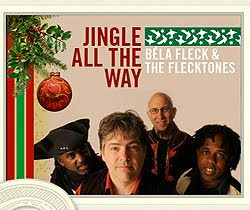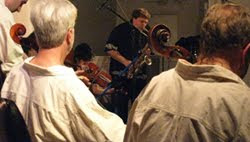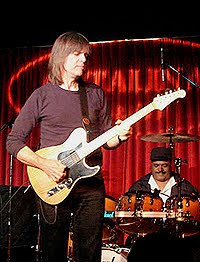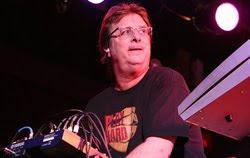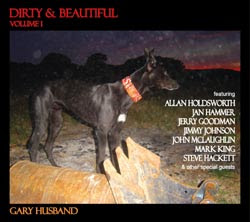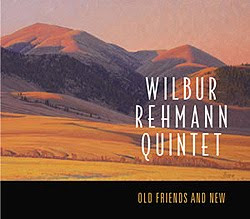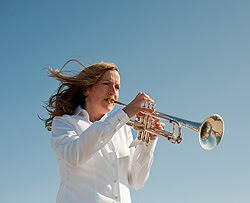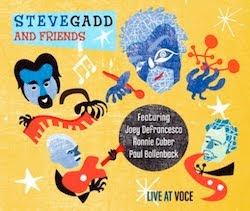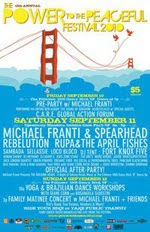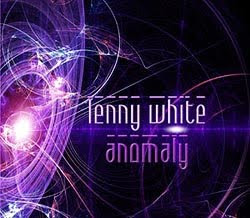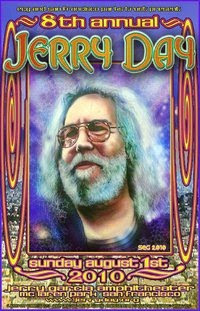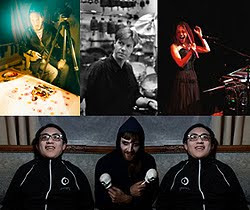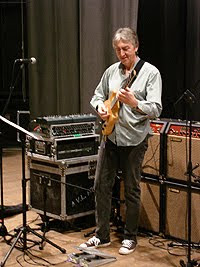
My all-time favorite guitarist is none other than the legendary Allan Holdsworth. I first saw him back in the late '70s, in one of the latter incarnations of the Tony Williams Lifetime; next with the British group U.K., featuring Bill Bruford, John Wetton and Eddie Jobson; and later, after seeing subsequent tours with his own incredible trio of bassist Jimmie Johnson and drummer Chad Wackerman, I knew I was witnessing pure guitar genius.
There is no one who sounds like the self-taught guitar wizard, though many have tried. His unique way of phrasing and beautifully crafted chords, is an extremely rare gift. Holdsworth is indeed, one of a handful of musicians who has consistently proven himself as an innovator within the worlds of rock and jazz music.
Many of music's best-known instrumental masters cite Holdsworth as that rare and shining voice—a legendary player who continues to push the outer limits of instrumental technique and the electric guitar's range of tonal and textural possibilities. Despite the uncompromising nature of Holdsworth's predominantly genre-defying solo projects, he's no stranger to all-star jazz festival line-ups or large venue rock audiences. His last performance at Yoshi’s was with Tony Williams alum Alan Pasqua, and recorded live on DVD. Holdsworth returns to Yoshi's for three more unforgettable nights with his long-standing trio featuring Wackerman and Johnson.
Allan Holdsworth is widely regarded by fans and contemporary musicians as one of the 20th century's most prominent guitarists. He is one of a handful of musicians who has consistently proven himself as an innovator in between and within the worlds of rock and jazz music. Many of music's best-known instrumental masters cite Holdsworth as that rare and shining voice—a legendary player who continues to push the outer limits of instrumental technique and the electric guitar's range of tonal and textural possibilities. Particularly during the 90s, Holdsworth has enjoyed the recognition so many musicians strongly feel he deserves, given that he has developed his career outside the big label mainstream and has consistently produced his own recordings with complete creative control since the mid-80s. Despite the uncompromising nature of Holdsworth's predominantly genre-defying solo projects, he's no stranger to all-star jazz festival line-ups or large venue rock audiences. Musician Magazine placed Holdsworth near the top of their “100 greatest guitarists of all time.” There's never been a shortage of media attention or acclaim for Holdsworth's accomplishments and originality. An inductee of Guitar Player Magazine's Hall of Fame, Holdsworth is a five-time winner in their readers' poll.
Beyond his ability in improvising mercurial solos and sculpting the guitar's voice into an ever-expanding range of textures and colors, Holdsworth has dedicated his energies to develop many different aspects of guitar technology. This has included new “baritone” variations of the instrument, his own custom 6-string designs (one most recently manufactured by Carvin), the invention of electronic components for the recording studio, and exploring the possibilities of guitar-based synthesizer controllers. Holdworth's ability to improvise over complex and challenging chord voicing's always reveals a deep emotional base and a strong, imaginative personality that is as instantly identifiable as any among Holdsworth's generation of guitar and jazz masters.
The sounds of Django Reinhardt, Jimmy Rainey, Charlie Christian, Joe Pass , Eric Clapton, and John Coltrane were among this English musician's early inspirations when he began to work professionally as a musician in his early twenties. Born in the city of Bradford , England , Holdsworth had been extensively tutored in aspects of musical theory and jazz appreciation by his father, an accomplished amateur musician. Holdsworth paid his musician's dues early on working the dance-club circuit, where he began to meet fellow musicians who hailed from the south. One of England 's best jazz tenor saxophonists, Ray Warleigh, heard amazing potential in Holdsworth's playing and brought him along to participate in jazz sets at the onset of the 70s, including sessions with Ray at Ronnie Scotts in London .
Holdsworth's career brought him to international audiences suddenly in the early 1970s, when he joined drummer John Hiseman's short-lived but much acclaimed “progressive” rock band, Tempest. A decade later, Tempest vocalist Paul Williams would team up with Holdsworth again to form Holdsworth's IOU band and create their independently-released debut recording, which prompted Holdsworth to move his home from London to Southern California.
Holdsworth's career throughout the 70s saw a series of feast-or-famine periods all too familiar to many of the most talented musicians. By 1975 Holdsworth had developed a reputation as one of England 's best, underrated guitarists in what was then the avant-garde of English instrumental music ensembles, the legendary group, Soft Machine. Holdsworth's trademark sound is evident with a technique that routinely soars with supersonic intensity, and one of its earliest available samplings can be heard on the 1974 Soft Machine studio release, Bundles . While his reputation in Soft Machine attracted international audiences, he also gained the attention of one of jazz's greatest drummers, the late Tony Williams, known for his pivotal role in bringing Miles Davis to explore rock-based riffs and motifs in an improvisational context. Holdsworth recorded on one of the most celebrated fusion albums from the mid-70s, Believe It , (Epic), as a member of the Tony Williams' New Lifetime. This marked the beginning of Holdsworth's career as a legendary journeyman, but one rarely performing before U.S. audiences.
Between 1976 and 1978 Holdsworth's guitar sounds and solos emerged as a mesmerizing tour de force and he participated in many of that era's landmark jazz-fusion and instrumental rock recordings by Jean Luc Ponty ( Enigmatic Ocean ), Gong ( Gazeuse! ), and Bill Bruford ( Feels Good To Me , One of A Kind ). Late in the 70s, the once dominant genre of classic British “prog rock” stumbled on unsure footing as the punk and new wave bands rose in commercial prominence. Drummer Bill Bruford, a founding member of Yes who later joined King Crimson, suggested Holdsworth participate in a new project featuring the formidable rhythm section of King Crimson and a brilliant young violinist/keyboardist Eddie Jobson, who had worked with both Frank Zappa and Roxy Music.
The resulting debut album, U.K . , became what was later considered the last and greatest milestones of 70s progressive rock. The band's sound was at the time both technically and artistically at the cutting edge of rock music, given the coupling of Jobson's innovative use of synthesizers and electric violins, coupled with Holdsworth's unconventional chord voicings, searing solos, and passionate melodic phrases. The U.K. “supergroup” setting was as brilliant as it was short-lived, and egos and questions of creative direction led to a split between Bruford and Holdsworth on one side, and Jobson and bassist John Wetton on the other. In 1996 Guitar World cited Holdsworth's contribution to U.K . as the factor in naming it one of the top 10 rock guitar albums “of all time.”
In 1978, Holdsworth decided he wanted to pursue a different, more live-based direction as opposed to his recent participation in lush, studio-crafted masterpieces. He sought out a more immediate, less intricately arranged band context than what had been established with Bruford, in order to explore a rock-oriented musical context that also explored extended instrumental ensemble improvisations. Holdsworth wanted to rediscover some of the energy and dynamics that had been so memorable in his live performances working with Tony Williams, and reluctantly parted company with Bruford's band. Holdsworth began to develop his own trio with two other Northern English musicians, drummer Gary Husband, and bassist Paul Carmichael, which begun Holdsworth's first touring band as a leader, the now-celebrated IOU band. Their first recording IOU sold exceptionally well for an independent release, and Holdsworth's friend and admirer, guitarist Eddie Van Halen, proved instrumental in securing IOU a recording contract with Warner Bros. Executive Producer Ted Templeman wanted to experiment with a “mini-album” concept, which resulted in the 1984 Grammy-nominated release, Road Games , which featured vocal cameos from long-time Holdsworth collaborator, the legendary Jack Bruce. It also featured a new American line-up, with Jeff Berlin and Chad Wackerman comprising the rhythm section. However tensions with the label over creative control led to a split between Holdsworth and Warner Bros. In 1985 Holdsworth signed with the Enigma label, enjoying creative control, and Jimmy Johnson joined the group after Jeff Berlin's departure to pursue his solo career. Holdsworth then recruited one of the most respected L.A. session bassists, Jimmy Johnson, leader of Flim and the BBs. The last version of the IOU band went back in the studio and with some notable guest appearances (among them bassist Gary Willis and original IOU drummer Gary Husband) contributed to tracks for the highly successful release, Metal Fatigue (1985).
In 1986 the release of Atavachron demonstrated Holdsworth's focus on instrumental music, continuing his core band with Johnson and Wackerman. Atavachron also featured stellar guest appearances by two of Southern California 's most sought after jazz keyboardists, Alan Pasqua and Billy Childs. Like other Holdsworth recordings to follow, it proved to be a summit for great drummers, with guest contributions from Tony Williams and Gary Husband. Husband's increasingly successful career eventually led to Holdsworth's appearance as a studio musician and band member with Level 42 for their 1993 release, Guaranteed . The follow-up to Atavachron , Sand (1988), marked a new period with Holdsworth concentrating on his exploration of the Synthaxe, a revolutionary guitar-like synth-controller.
Holdsworth received the winning award in Guitar Player Magazine's poll as “best guitar synthesist,” for many consecutive years afterward. With Secrets (1990) Holdsworth returned to his association with Enigma records, (which became the Restless label) featuring an album recorded mostly with the great session drummer Vinnie Collaiuta, who later joined Sting's band and had previously worked with Frank Zappa and Jeff Berlin. Secrets further revealed Holdsworth's rich harmonic vision and unleashed more distinctively “Holdsworthian” music, an enigmatic style that continues to invert, push, and transform the boundaries of more conventional rock, fusion, and jazz forms.
During this period the keyboardist from Stanley Clarke's touring band, Steve Hunt, joined Holdsworth's band. In the early 90s, Holdsworth also appeared in a jazz “supergroup” and at festivals with other great jazz and fusion legends, including Stanley Clarke, Billy Cobham, and Michael and Randy Brecker among others. 1992's Wardenclyffe Tower furthered an exploration of Holdsworth's own designs for baritone electric guitars (built by luthier Bill DeLap) and broadened the use of his chordal orchestrations and solo phrasings via the SynthAxe. In 1994, Hard Hat Area was released on Restless with the latest version of Holdsworth's band, including Icelandic bassist Skull Sverrisson, Gary Husband, and Steve Hunt, providing one of his most satisfying projects from the quality of group interplay and capturing the band closer to its live performance context. The release of Holdsworth's next album project, None Too Soon (1996) marked a departure in style from this impressive string of previous group projects. It provided Holdsworth the opportunity to showcase his interpretation of some classic jazz standards and several originals by one of England 's best-known jazz pianists, Gordon Beck.
Holdsworth recorded some of his favorite, lesser-known jazz standards, along with several Gordon Beck originals, in a “straight-ahead” jazz vein, drawing upon Beck's talents as an arranger. The rhythm section teamed for the project included bass prodigy Gary Willis and drummer Kirk Covington, both members of the West Coast based fusion powerhouse, Tribal Tech. None Too Soon built upon the same chemistry established in a brief recording session of the same musicians featured on a Beatles guitar tribute titled “Come Together,” (1994, NYC Records) in which this same group covered Beck's arrangement of the Beatles' “Michelle.” In None Too Soon , Holdsworth produced a refreshing jazz recording that realized a different perspective on his playing, while demonstrating his appreciation of standards as penned by John Coltrane, Bill Evans, Django Reinhardt and Joe Henderson. None Too Soon offers listeners a compelling and swinging musical journey, including a riveting, updated interpretation of Irving Berlin's “How Deep Is The Ocean” and a blistering twist on the Lennon/McCartney classic, “Norwegian Wood.”
Building on the supreme sonic craftsmanship Holdsworth realizes in his home studio in Southern California , The Brewery, Holdsworth's latest solo recording is certain to be singled out as one of his greatest musical masterpieces. The Sixteen Men Of Tain marks a further exploration of traditional jazz motifs, and, as a first on his solo projects, an acoustic rhythm section. Holdsworth's tenth solo album marked the debut of a new band formed with bassist Dave Carpenter and drummer Gary Novak, both West Coast session men. First released in 2000, a special edition with two additional tracks was released via Eddie Jobson's label, Globe Music, in summer of 2003. Tain marked a new direction in a forward-looking jazz vein and blended together a new vision explored to a degree in the more traditional jazz arrangements found in None Too Soon.
One frequent topic of discussion among Holdsworth devotees was the fact that after well over a decade of touring with stellar players, Holdsworth had never approved the release of any live recordings by his bands, or any of those with him as a guest performer for that matter. In Fall 2002, Sony Japan released Holdsworth's first ever live recording, featuring Jimmy Johnson and Chad Wakerman in which Sony featured the trio's performance show as a showpiece for their next generation of state-of-the-art five-channel sound technology. In late 2003, Alternity Records will release a second landmark Holdsworth live recording, Then! featuring a quartet performance from 1990 with keyboardist Steve Hunt, along with original IOU drummer Gary Husband, and Jimmy Johnson. Recorded originally in digital 24-track, Then! covers material from a broad swath of Holdsworth's recording career, from his days with Tony Williams' Lifetime up through Hard Hat Area and includes three never-released group improvisation tracks, not to mention some of Holdsworth's most powerful and ferocious solo flights ever captured on tape. Holdsworth spent time later in 2002 completing production duties for the recently released Softworks album Abracadabra , which featured alumnus from different eras of the legendary English experimental band, Soft Machine. Holdsworth toured with the band in Japan in the summer of 2003, which included saxophonist Elton Dean, bassist Hugh Hopper, and drummer John Marshall.
In the past decade Holdsworth has varied his music career, engineering and inventing electronic sound-processing tools, including The Harness. He has several unique electric guitar designs now produced by Carvin, and has worked with luthier DeLap in conceiving custom baritone and piccolo guitars. In fact one of the larger and longer baritones is featured on all three improvised pieces in the new live album, Then! In his expanded and improved home studio, Holdsworth is already writing material for a new album of original pieces, and is planning to participate as a guest musician in several other projects as an engineer/producer. Whether he is playing instruments with the latest electric guitar innovations, piccolo, baritone guitars, or the Synthaxe, Holdsworth remains never quite satisfied in his eternal “quest for the perfect tone."
With the Bay Bridge closing for Labor Day Friday night, San Franciscans may yet have their chance to catch Holdsworth via BART; for those lucky few already in the East Bay, spend some time with one of the greatest electric guitarists of all time.
Allan Holdsworth, with Jimmy Johnson & Chad Wackerman at Yoshi's, Jack London Square
Fri 8pm $24 & 10pm $16
Sat 8pm & 10pm $24 Sun 7pm $24 & 9pm $16
Day of Show: additional $3 per ticket
